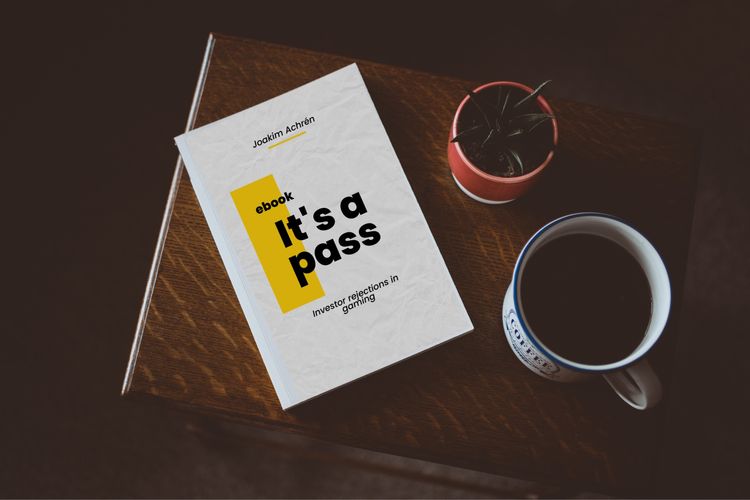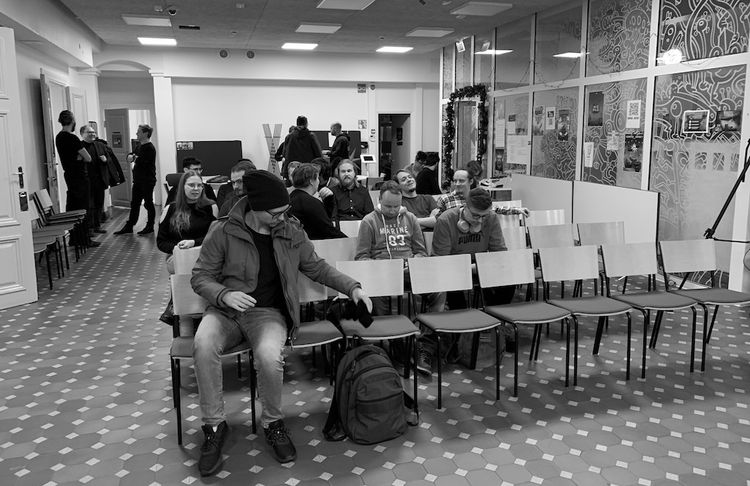EGD News #40 — Accessible VC
This newsletter was sent out on July 31st 2020. If you’re reading this and you aren’t a subscriber, you can sign up here.
On to this weeks topics.

🎮 Accessible VC
In 2007, I was approached by a venture partner from a prominent London based VC firm. This person was looking at Nordic startups and liked what my company Ironstar Helsinki was building.
We were at the early stage. We’d launched the beta version of our mobile virtual world MoiPal in December 2006 and spent the previous six months iterating on the experience, including a desktop browser version for the virtual world.
I had been pitching the company to a few Helsinki-based VCs. Back then, there weren’t any VCs doing consumers in Finland, not to mention any gaming investors. The feedback was never very actionable. Instead, they were all waiting to hear our numbers.
I eventually traveled to London for a meeting at this prominent VC firm, with all the general partners in the meeting room. After presenting my pitch deck for a few minutes, the main partner just walked out of the room. That moment was a signal that I’d blown the opportunity. I had spent so much money to fly over, to witness the investor walking out of the meeting. It felt so bad.
Later, I heard from the venture partner that, at the moment, they wouldn’t pursue an opportunity to invest. And that was that then.
I eventually did raise a round from a Finnish VC, but I stayed in the pitching “trenches” for an additional 18 months after that dreadful London meeting.
Why did it take so long?
- There weren’t many VCs investing in gaming in the ’00.
- I didn’t know what VC expects, and what was expected of me.
- Reaching out, pitching, waiting for weeks to get an answer/follow-up meeting, and at some point, getting a decision.
But nowadays, founders can act differently. We have hundreds of VCs in Europe who invest in consumer businesses, and many are happy to look at gaming deals. Founders have more knowledge of what VCs expect. At least the information is more readily available.
Now let’s fix the accessibility and reduce the time that you need to spend in the trenches.
Transparency
I believe that we need more transparency, if not rules, for how VC and founder interactions should happen. One way to achieve this is to create a format of accessible VC.
I do not mean that money is given out without a process, but that it becomes more pleasant and accessible for founders.
Communication standards and preferences have always been a barrier. For the founder, how do they communicate all their beliefs, insights, process, and velocity of execution? And for the VC side: why they invest, what is something they might invest in, what does “too early” or “too late” mean?
Cold emails
The good thing about the VC model is that VCs live from a broad deal flow. They have staff, filtering through hundreds of possible deals every month, and allocating time on the deals that make the most sense.
But founders don’t have assistants to filter VCs for them. The only approach is to add more VCs to a list and start cold emailing. This way, they can quickly reach many VCs, but their emails might end up in the spam folder, or just get ignored.
If you are an experienced founder, who has been in gaming for years, the best way to get investor meetings is to go through intros. You’d ask a friend, perhaps a founder, to introduce you to investors or VC friends. Your friend filters for the VC, and you’ll most likely get to a meeting.
If you are inexperienced and don’t have a network to utilize, the best option is to go for a cold email.
Note: Your objective is to get to a first meeting with the VC. Not to get them to invest right now. That will happen much later in the conversations.
Northzone VC’s Paul Murphy, who was on the EGD Podcast in March, wrote on Twitter about his preferences on cold emails, which he doesn’t mind at all. He pointed out a model that should work optimally for both the founders and the investor’s sake.
Cold emails to VCs can be very simple
- We’re building __ for __ and why
- Raising €/£/$__ + funding history + traction
- You / your fund is interesting to us because of ____
- Team/founders based in ___
- Attach or link an overview
- Ask for feedback if they say not a fit
Things not to do: (which are pretty obvious)
- Apologize for sending a cold email
- Send to a distribution list or BCC multiple investors
- Send to funds that aren’t relevant – Get upset if a VC is honest that it’s not a fit
A couple of critical observations here.
“and why”: By covering this one, it opens up why the founder is doing what they are doing. It reveals the commitment and attachment of the founder. In gaming, the big question is ”why the gaming world would need your game?”
“+ traction”: What have you achieved so far, what have you built on your own, and do you already have players? If the founder isn’t a gaming superstar, VC don’t fund the “founders with an idea” stage. Usually, it takes a prototype and some insight into the audience and the market.
“your fund is interesting”: You have chosen to reach out to the investor because you’ve read about them, heard good things from other founders, or that you’re convinced that they’d be a great partner in building your company. Your interest in this particular investor matters, as it shows initiative on screening the right people to work with in the future.
“overview”: One-pager about the company, with some visualswill give the company’s highlights to the investor so that they can make the time for talking to you. Make it easy to read on a mobile screen. Don’t send an investor deck yet; one or two pages of readable material is excellent.
“Ask for feedback if they say ’not a fit’”: Use the opportunity, especially if the investor didn’t point out why they made the decision.
The Venture Capital Product
Fred Destin is the founding partner of Stride.VC, and a former partner at Accel Partners. In May of 2020, Fred had posted a question to his followers on Twitter:
“If you could make the “venture capital product” a better experience for founders – what would you change?”
The Tweet got over 60 retweets and comments. Here are five of the most interesting findings from this converse between Fred and his followers. There was a Medium post that Fred put together on the Tweet and its comments.
1. How do you know which VCs to target and what they are specifically looking for?
“First-time founders have very little data to help them understand what funds and partners they should engage. There is no quantitative measure for how helpful a fund might be except for cash.”
Joakim: Current ways to find out about VCs is mainly through word-of-mouth, which is far from optimal if you want to have a diverse pool of founders building companies.
2. VCs have an investment thesis, but no public checklist.
“Most of the time it feels like founders have to fit the VCs’ cookie cutter, although it’s never clear what the boxes are that need to be ticked.”
Joakim: Startup investing is indeed nuanced, especially around timing, where the markets and competitors are. But explaining and going through previous investments, where timing mattered, the transparency would matter to founders.
“[The] game of cat and mouse drives founders mad.” There are unspoken rules, but founders don’t have so much time to navigate all the ways to get to a YES.
3. Requiring product-market fit (PMF) to invest. Is it enough? And when doesn’t it even matter?
“Sometimes the only way to see PMF is some level of revenue. Other times the VC, market, product, or some combo of above means that isn’t needed. Anyone who boils VC down to a series of boolean questions probably isn’t doing it very well.”
4. Can I just get a NO
The best way for investors to help any founder is to get to a decision quickly.
“Founders want VCs to ‘stop wasting their time’ are dying for shorter, continuous feedback loop and clear no’s.’ So easy yet so hard apparently.”
Joakim: I’ve met several investors who do state early on how they approach investing. They might want to have several months of a getting-to-know phase before they invest. Or some say ”we’ll give you a decision tomorrow,” based on one meeting. But not all of them state their process clearly, on their websites or in the meetings with founders.
5. Improved pitching process
Pitching is a time sink. Any founder can relate to this. “Many ask for a “streamlined, standard way to pitch broadly.”
“Allow founders to pitch all the VCs at once. The idea of doing 5–10 meetings a week is keeping me bootstrapping!”
After Fred published a Medium post about the Twitter discussion, VCs started reacting. Founders’ Co-op released their core values, to make things more transparent to the founders.
I’m hoping that more VCs will follow these examples and make their process easier for founders.
📄 Blog
For some holiday reading, I thought I’d send out my most read articles of H1 2020.
- 9 lessons for understanding gaming investors
- “Start with Why” for gaming entrepreneurs
- Gaming Startup Cashflow
- How To Avoid Risks In A Gaming Startup
- Stock options in a gaming startup
- 10 Reasons Why Investors Say NO
- Retention Metrics in Free-To-Play
- 7 Ways A Gaming Startup Can Show Traction
- Magical Pairs In Game Development
- Games startup funding during a pandemic
- 4 ways hyper-casual games have benefited the gaming industry
- How to make a video game
- How To Work With Gaming Startup Advisors
- Sales Projections For Premium PC Games
- How to be an angel investor in the games industry
The top three is very diverse in topics, which is great to see!
Some additional thoughts on these:
- The “Start With Why” article is definitely my favorite and I’ll definitely cover the beginnings of startups more during H2
- “Magical Pairs” was the hardest to write
- “How to make a video game” is great but deserves a followup
🎙 Podcast
In this episode, I talk with Jussi Autio from Resistance Games on how premium game developers can predict sales and revenue, incl. publisher contracts. Check out the template from Jussi by going to the site.
— EGD Special: Sales Projections For Premium PC Games
🗓 Last week
If you missed out on the EGD news last week, I shared my highlights from Joseph Kim’s Gaming VC panel, featuring Jason Chapman from Konvoy Ventures, David Gardner from London Venture Partners and Graham Gockley from Transcend Fund.
— EGD News #39 — Gaming VC panel
📃 Articles worth reading
+ Nintendo, Disney, and Cultural Determinism — Matthew Ball wrote an essay on Nintendo, comparing the differences of a similar company like Disney, who has evergreen IP and entertainment property where no other compares. Ball highlights the reasons why Nintendo is different. “[Nintendo makes] hardware so that its development arm can make the games it wants to make, which also happens to be hardware that other developers can distribute their games through but mostly don’t.”
+ The Economy of the Metaverse — Here’s a high dose of what the Metaverse could look like. Joseph Kim recently interviewed Epic CEO Tim Sweeney, and there’s some really futurist Metaverse pointers covered around platforms, games and creator economies. “The talk about [the Metaverse] is it’s not just the work of one company. It’s not just one company’s product or revenue stream. We’re talking about a mass participatory media, which needs to be an economy.”
+ The Adjacent User Theory — This is an article, written by former Instagram VP of Growth Bangaly Kaba, on how they realized that to grow Instagram from 400mm to 1bn+, they needed to react to a group called the Adjacent Users. As Bangaly writes, these users are “aware of a product and possibly have tried using the it, but are not able to successfully become an engaged user.” I believe there a similar groups in gaming, which could potentially become players and fans for life.
+ Trends in Investment and Mergers & Acquisitions — A while ago, I was asked a bunch of questions on the gaming investment and M&A landscape. The article is out and it’s a good take how investments and M&A have been developing during 2020 and COVID. “Pitching a “metaverse” is the hot thing that everybody does, but it will come done to having a great game. The “metaverse” stamp doesn’t matter to the consumers, you’ll need to prove it with a great game.”
💬 Quote that I’m thinking about
”Take a simple idea and take it seriously”
— Charlie Munger
👀 Something cool
I’m a big believer in online courses being a great way for people to gain knowledge on any topic. Especially when you have experts talking about a topic on live video, through actionable examples.
I’m looking forward to these Masterclasses that Pocket Gamer is organizing in August. You can read more about them by going here.
Sponsored by ironSource
We all know that developing a great game is one thing, but developing a great game business can be something else entirely. That’s why some of the top game developers in the industry use ironSource’s game growth platform, which takes care of both sides of the business, helping you monetize to fuel user acquisition, and vice versa.
From their ROAS Optimizer, the only product on the market built to optimize UA campaigns towards ROAS according to both IAP and ad revenue data, to LevelPlay, their in-app bidding solution, they offer everything you need to supercharge your growth. See for yourself at ironsrc.com
That’s it for this week. Stay safe and enjoy the sun!





